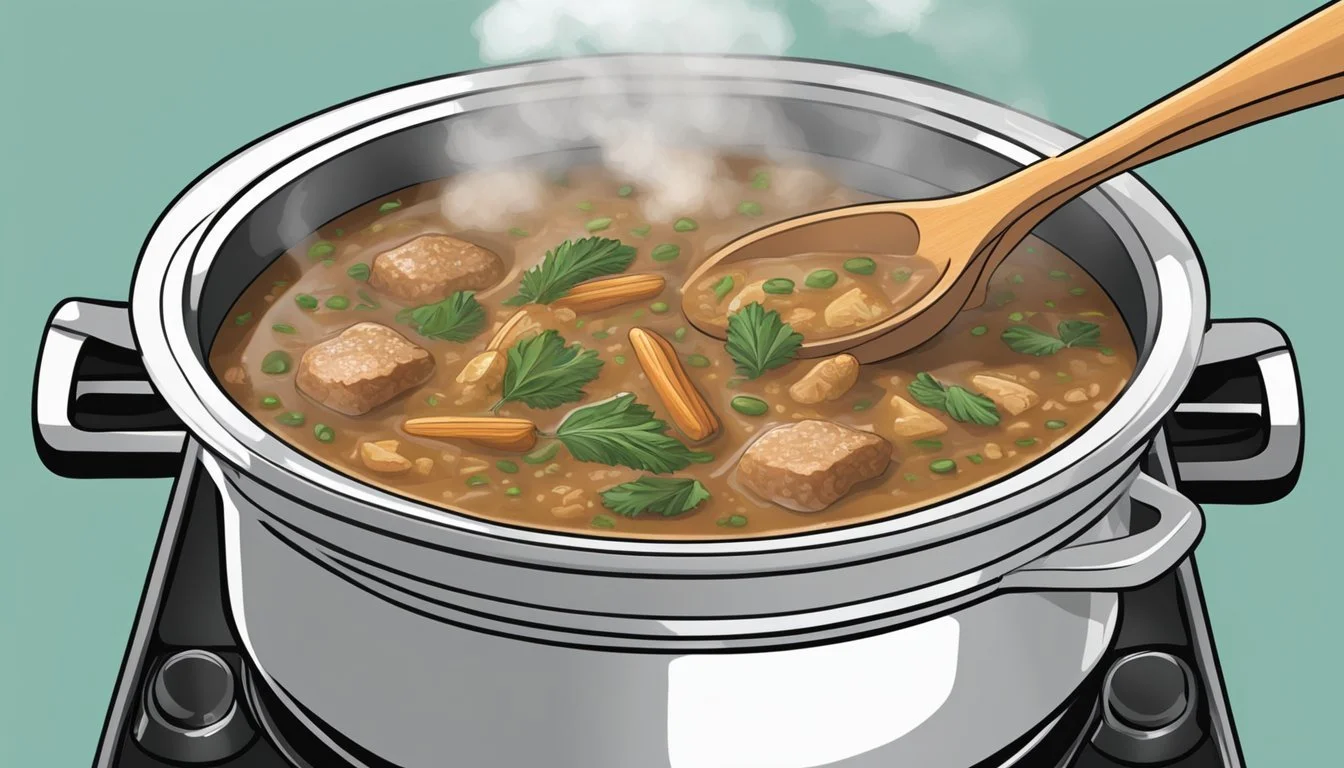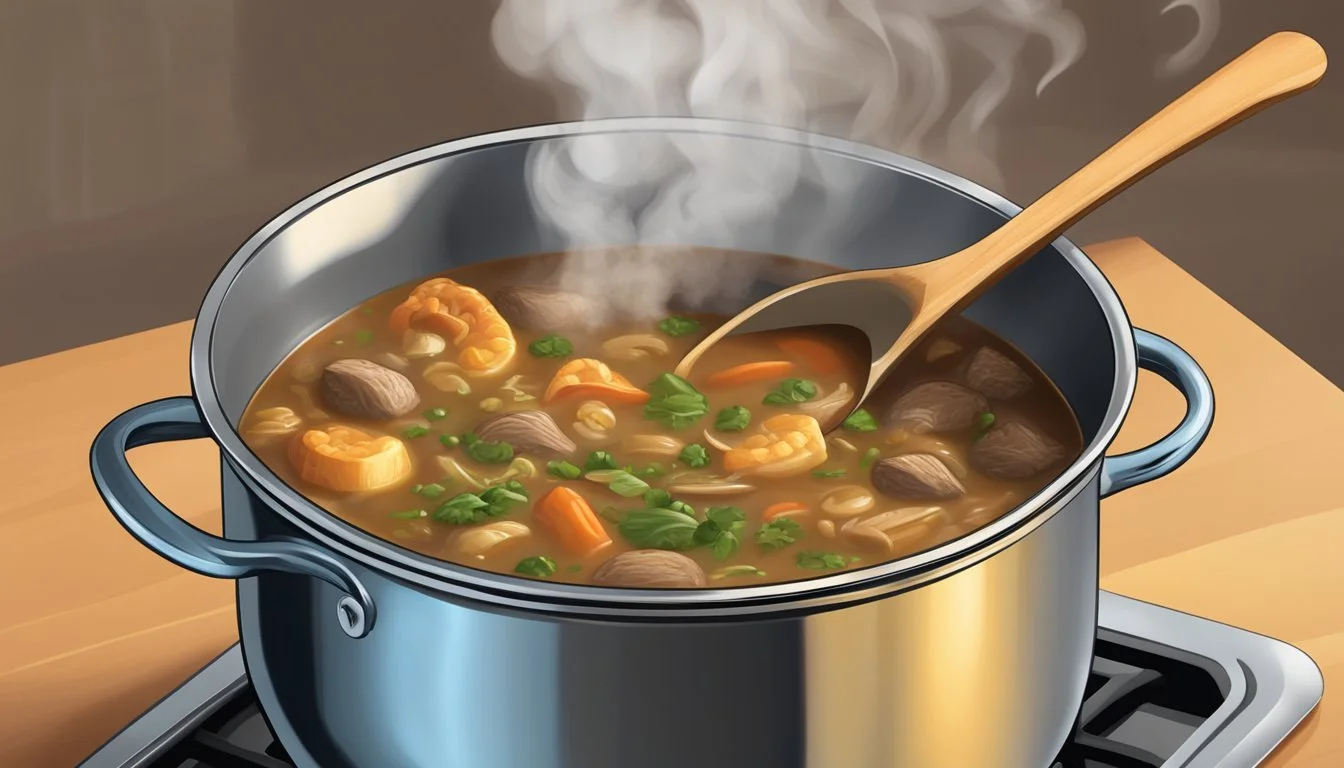How to Reheat Gluten-Free Gumbo
Best Methods for Maximum Flavor
Reheating gluten-free gumbo can be a bit tricky, but with the right approach, it’s perfectly manageable. To prevent any separation of the roux and maintain the savory depths of flavor, use controlled heating methods like the stovetop or microwave with intermittent stirring. This ensures that your gumbo remains just as delicious as when it was freshly made.
If using the stovetop, place the gumbo in a saucepan and heat on low-medium. Stir frequently to evenly distribute the heat and prevent the gluten-free flour in the roux from clumping or separating. Alternatively, employ the microwave by covering the gumbo with a microwave-safe cover and heating it in one-minute intervals, stirring between each to maintain a smooth consistency.
For those who are health-conscious, a gluten-free gumbo offers an accessible way to enjoy this Southern classic. Making your roux with gluten-free flour is the only modification needed, allowing you to enjoy the traditional flavors without compromising dietary needs. This post will guide you through the most effective techniques to enjoy your reheated gumbo at its best.
Understanding Gluten-Free Gumbo
Gluten-free gumbo provides an authentic taste of New Orleans while accommodating dietary restrictions. Key elements include a gluten-free roux and specific ingredients to maintain flavor and texture.
The Basics of Gumbo
Gumbo is a rich, thick stew originating from Louisiana. Traditionally, it includes vegetables, meats, and seafood, often seasoned with Cajun or Creole spices.
The most critical component is the roux, which is a mixture of flour and fat cooked until browned. In gluten-free versions, gluten-free flour replaces wheat flour, providing a similar consistency.
Gumbo also typically contains the “Holy Trinity” of Cajun cooking: onions, bell peppers, and celery. Common proteins include shrimp, chicken, and andouille sausage.
The Importance of Gluten-Free Ingredients
Using gluten-free ingredients is crucial for those with gluten intolerance or celiac disease. The primary replacement is gluten-free flour in the roux.
Gluten-free flours like rice, almond, or chickpea flour work well. It’s important to check labels on all packaged ingredients to avoid hidden gluten sources.
This adaptation does not sacrifice the dish’s robust flavors or hearty texture. Ensuring all ingredients, including any broth, seasonings, and meats, are gluten-free maintains the dish’s authenticity.
Proper substitutions enable everyone to enjoy this beloved Louisiana staple without compromising their health.
Ingredients Analysis
To reheat gluten-free gumbo effectively, it's crucial to understand the ingredients used in its preparation. Key components include the choice of protein, the "holy trinity" of vegetables, and gluten-free thickening agents. Each set of ingredients contributes uniquely to the gumbo's flavor and texture.
Choosing the Right Protein
Chicken, shrimp, and andouille sausage are common proteins in gluten-free gumbo. Opting for rotisserie chicken can save time, while chicken thighs provide rich flavor. Adding raw shrimp at the end of cooking ensures they remain tender. Plant-based proteins are excellent for vegetarian versions, offering versatility without compromising flavor.
The Holy Trinity of Vegetables
The "holy trinity" consists of onion, celery, and bell peppers. These vegetables form the base of the gumbo, imparting essential flavors. Garlic and tomatoes can enhance complexity, while okra not only adds taste but also acts as a natural thickener. Using a mix of green, red, and yellow bell peppers can provide a depth of flavor and color.
Gluten-Free Thickening Agents
Traditional gumbo often uses a roux made with wheat flour, but gluten-free versions require alternatives. Rice flour and gluten-free all-purpose flour are good options for the roux. Okra and file powder (ground sassafras leaves) can also thicken the dish naturally. For those avoiding grains, arrowroot or cornstarch can provide the desired consistency without altering the flavor significantly.
Preparing Your Gluten-Free Gumbo
Creating a delicious gluten-free gumbo requires careful preparation of the roux, vegetables, and broth to ensure rich, authentic flavors. Use gluten-free flour, a mix of fresh vegetables, and various seasonings to enhance the gumbo.
Making the Gluten-Free Roux
To achieve a flavorful gluten-free roux, begin by combining equal parts oil and gluten-free flour. Use a Dutch oven for even heat distribution. Stir the oil and flour mixture constantly over medium heat for 15 to 25 minutes.
It should reach a copper-brown color, indicating it is ready. The constant stirring is crucial to avoid burning. This roux acts as the base for traditional Cajun flavors, crucial for any authentic gumbo.
Cooking the Vegetables
Incorporate the holy trinity of Cajun cuisine: onions, bell peppers, and celery. Start by heating a skillet with avocado oil and sautéing the vegetables until the onions become translucent and the peppers tender. This usually takes a few minutes.
Add minced garlic and cook until fragrant. The mixture of vegetables provides the essential base flavor, complemented by the roux.
Simmering the Broth
Choose between seafood stock or chicken broth, depending on your preferred protein. Pour the broth into the pot with the roux and vegetables and bring it to a simmer. Add seasonings like bay leaves, thyme, and Cajun seasoning to enhance the taste.
For an extra kick, cayenne and black pepper work well. Ensure to use low sodium options for healthier meal choices. As it simmers, the flavors meld together, creating a rich, hearty gumbo perfect for any occasion.
Reheating Gluten-Free Gumbo
The keys to perfectly reheating gluten-free gumbo lie in preserving its flavorful texture and ensuring it reaches the safe temperature for consumption. Here are three effective methods: stovetop, Instant Pot, and microwave.
Stovetop Method
Reheating gumbo on the stovetop is ideal for retaining moisture and rich flavors. Begin by transferring the gumbo from an airtight container into a large pot. If it’s been refrigerated, allow it to reach room temperature first. Set the burner to medium heat, stirring frequently to prevent sticking and ensure even heating.
Add a splash of broth or water if the gumbo appears too thick. This helps maintain its consistency. Heat until the gumbo simmers, and make sure it reaches an internal temperature of 165°F (74°C). This method is particularly effective for keeping the texture and flavor intact.
Using an Instant Pot
The Instant Pot provides a quick and efficient way to reheat gluten-free gumbo. Transfer the gumbo into the Instant Pot’s inner pot. If needed, add a small amount of broth to prevent burning. Close the lid and select the "Sauté" function first, allowing a few minutes for initial heating.
Switch to the “Keep Warm” function to gently bring the gumbo to the desired temperature. Frequently stir to avoid sticking at the bottom. Ensure it reaches an internal temperature of 165°F (74°C). This method reduces the risk of overcooking while preserving the gumbo’s flavorful texture.
Microwaving with Care
Microwaving is convenient but requires careful handling to ensure even heating. Place the gumbo in a microwave-safe container. Cover with a microwave-safe cover to prevent splattering. If the gumbo includes rice, reheat it separately to avoid a gummy texture. Microwave the gumbo in one-minute intervals on medium power, stirring between intervals.
Check the internal temperature, ensuring it reaches at least 165°F (74°C) before consuming. This method is quick but requires attention to maintain the gumbo's consistency and flavor. Ensure that you fluff the warmed rice with a fork before serving to improve its texture.
Storing Gluten-Free Gumbo
Proper storage of gluten-free gumbo is crucial to maintain its flavor and prevent spoilage. Key considerations are refrigerating for short-term use and freezing for long-term preservation.
Refrigeration Best Practices
Store gluten-free gumbo in airtight containers to prevent moisture loss and contamination. Use containers made of glass or food-grade plastic. Place the gumbo in the refrigerator within two hours of cooking to avoid bacterial growth.
Refrigerated gumbo should be consumed within three days. When reheating, ensure it reaches an internal temperature of 165°F (74°C). Use medium heat and stir occasionally to maintain an even temperature and texture.
If using avocado oil in the recipe, it helps preserve the flavors and freshness of the gumbo due to its stability at various temperatures.
Freezing for Long-Term Storage
Once the gluten-free gumbo has cooled completely, it can be stored in the freezer for up to three months. Transfer the gumbo to freezer-safe, airtight containers or heavy-duty freezer bags to prevent freezer burn.
Label the containers with the date of storage. To reheat, thaw the gumbo in the refrigerator overnight. For reheating, either use the stovetop over low-medium heat or the microwave, stirring occasionally to ensure even heating.
The texture and taste will remain intact if these steps are followed properly, ensuring a fulfilling meal whenever you choose to enjoy it.
Serving and Pairing Ideas
When serving gluten-free gumbo, consider complementary side dishes and flavorful toppings that enhance its rich flavors. Pair traditional options with creative choices for a delightful dining experience.
Complementary Side Dishes
To complement the flavors of gluten-free gumbo, consider offering white rice or cauliflower rice. Both provide a neutral base that absorbs the rich, spiced broth.
For a more hearty accompaniment, serve a classic Southern potato salad. Its creamy texture and mild taste balance the Cajun flavors of the gumbo, making it a popular choice.
Lightly seasoned roasted okra or sautéed green bell peppers can add a crunchy element to the meal. These vegetables bring a fresh contrast to the robust gumbo, enhancing its depth of flavor.
Another excellent option is a French baguette, perfect for soaking up the savory gumbo liquid. Ensure it’s gluten-free to maintain consistency.
Mushrooms and potatoes in a simple sauté can round out the meal, providing earthy notes that harmonize well with the gumbo’s bold spices.
Enhancing Flavors with Toppings
Enhance the gumbo with a variety of toppings that add both texture and flavor. Chopped green onions bring a fresh, slightly tangy note, while a dash of hot sauce can elevate the heat for those who enjoy a spicier dish.
Consider a sprinkle of dried oregano or other aromatic spices to add complexity. For an extra layer of taste, drizzle a bit of chili oil to infuse a subtle smokiness.
To thicken the gumbo, a cornstarch slurry can be stirred in during reheating, ensuring the consistency remains perfect.
Lastly, offer grated cheese or a dollop of sour cream as optional garnishes, providing a creamy contrast that melds beautifully with the gumbo’s spice profile.
Gluten-Free Gumbo Variations
Gluten-free gumbo offers a range of options, from hearty seafood and chicken mixtures to plant-based and vegan alternatives. Each variation caters to different dietary preferences and culinary tastes, ensuring everyone can enjoy this classic dish.
Seafood and Chicken Gumbo
Seafood and chicken gumbo typically combines shrimp, crab meat, and chicken for a flavorful dish that retains the essence of traditional Creole gumbo. This variant often includes gluten-free sausage, adding a smoky taste. The Cajun flavor can be enhanced with spices like paprika, thyme, and bay leaves.
For thickening, a gluten-free roux made from alternative flours (such as rice or almond flour) substitutes for wheat flour.
Ingredients:
Shrimp: adds a delicate seafood taste.
Chicken: provides a hearty protein source.
Crab meat: enhances the seafood richness.
Sausage: adds smokiness and depth.
Okra: helps thicken and adds texture.
Short cooking times for seafood combined with longer times for chicken ensure a balanced texture and flavor. This variant remains kid-friendly while delivering complex, savory flavors.
Plant-Based and Vegan Options
Plant-based and vegan gumbo variations substitute meat with vegetables, beans, and plant-based proteins. Popular ingredients include okra, bell peppers, celery, and mushrooms.
For a vegan roux, use oil-free methods by baking gluten-free flour in a skillet. Jambalaya seasoning adds depth, while herbs like thyme and bay leaves maintain authentic flavors.
Ingredients:
Okra: provides thickness and a unique texture.
Bell peppers and celery: add the essential aromatic base.
Mushrooms: offer a meaty texture without animal products.
Beans: provide protein and bulk.
Cooking times may vary, with vegetables often needing shorter times than traditional meats. These options ensure the gumbo retains signature Cajun flavor without animal products, making it suitable for a broader audience while respecting dietary preferences.
Mastering Gluten-Free Cooking Techniques
Mastering gluten-free cooking involves developing skills to create classic flavors and achieving the right textures, essential for comfort foods like gumbo. Central to this are roux cookery skills and understanding how to achieve the perfect texture.
Roux Cookery Skills
In gluten-free cooking, making an effective roux is vital. Traditional roux uses all-purpose flour, but for gluten-free gumbo, alternatives like cassava flour or rice flour are excellent choices. They deliver a similar thickening power without the gluten.
Start by heating equal parts of gluten-free flour and oil in a skillet over medium heat. Stir constantly to prevent burning. The flour will gradually darken; for gumbo, aim for a dark brown roux, which imparts rich flavor.
Consistency is key. Avoid lumps through constant stirring and adjusting the heat as needed. Mastering this allows for a smooth and flavorful base for various gluten-free dishes.
Achieving the Perfect Texture
Achieving the perfect texture in gluten-free gumbo goes beyond the roux. The right mix of ingredients and cooking techniques is crucial. Use gluten-free thickeners like filé powder, which not only thickens but adds a distinct earthy flavor.
Ensure proteins like chicken, shrimp, and sausage are cooked to the right tenderness. Overcooking can lead to tough textures, while undercooking can leave them unappetizing.
Vegetables should be lightly sautéed before combining with other ingredients, ensuring they retain some firmness. For added thickness and texture, combining cassava flour with stock can create a slurry, which, when added to the gumbo, can enhance its body.
The balance between ingredients and cooking methods is essential for the dish's comfort food appeal.
Final Tips and Tricks
For the best results when reheating gluten-free gumbo, always use fresh ingredients where possible. This helps in maintaining the authentic Louisiana flavors.
When reheating in a microwave, use one-minute intervals on medium power. Stir between each interval to ensure even heating. Make sure the internal temperature reaches 165°F (74°C).
Cover the dish tightly with a microwave-safe cover or tempered glass plate to prevent splattering and moisture loss.
If using an oven for reheating, preheat to 350°F. Transfer the gluten-free gumbo into an oven-safe container, cover with foil, and heat for 20-30 minutes. This method works particularly well for one-pot and New Orleans-style gumbo.
For a more delicate reheating process, consider the Bain-Marie method: Place the gumbo dish inside a larger dish filled with hot water, then bake. This helps retain moisture and flavor.
Stirring occasionally while reheating is crucial. It helps distribute flavors evenly and prevents hot spots.
Adding freshly sliced vegetables or shredded chicken can enhance the flavor and fiber content. Use fresh herbs like dried bay leaves to rejuvenate the taste.
When reheating, use appropriate measuring cups to ensure correct portions, especially if reheating multiple servings. Avoid adding raw ingredients late in the reheating process; they may not cook thoroughly.
For a flavorful finish, a dash of fresh spices or herbs can be sprinkled just before serving. This can bring out the best in your soup or stew style gumbo.
Keep these tricks in mind for a delicious and safe reheating experience.











